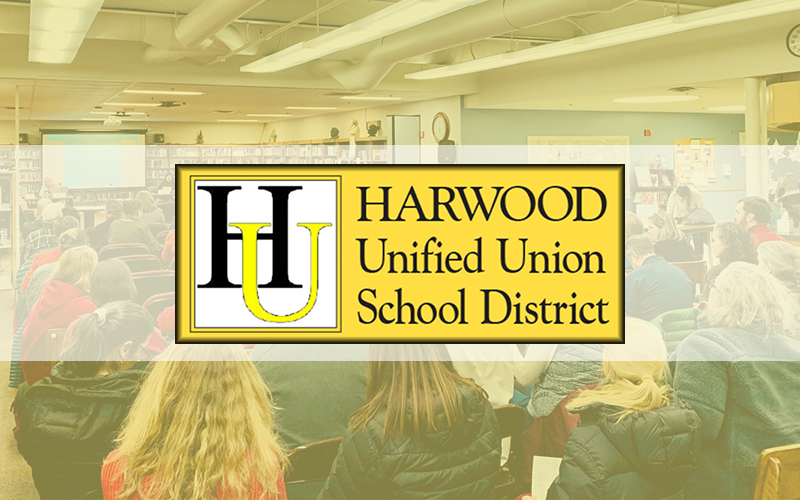The Vermont Legislature has not yet made a decision about whether it will allow school districts without approved budgets to borrow an amount equal to their fiscal year (FY) 2020 spending levels. Still, even without direction from the Legislature, the Harwood Unified Union School District (HUUSD) Board was able to make progress in narrowing down potential budgets for FY21.
At a meeting on May 6, the HUUSD Board made two budget-related decisions. First, board members voted to eliminate two budget options. The first, which the board now refers to as budget C, had been considered even before the Legislature proposed a bill that would impose budgets on budgetless school districts. It’s the no-restrictions-on-IDC budget. This budget would save $300,000 while allowing for staff additions to accommodate IDC, the policy that allows students to transfer to any other school in the district.
Board chair Caitlin Hollister clarified that eliminating budget C doesn’t mean eliminating the IDC policy. “We would still be saying yes to many IDC applications, but they wouldn’t be unlimited,” said Hollister.
The board also voted to eliminate budget F, a new budget that considers a possible outcome of a legislative vote. This budget describes the outcome of a bill that, if passed, would allow budgetless school districts to spend their FY20 budget amounts plus a 4% inflation factor. For the HUUSD, total expenditures for this budget add up to $41,158,899 and have an estimated equalized homestead tax rate of $1.72, which is 7 cents higher than the $1.65 equalized homestead tax rate of the budget denied on Town Meeting Day.
The vote to eliminate these two budget options passed unanimously, with all 13 board members in favor of the decision.
The board made it clear that they wanted to put a cap on education spending during this time of economic hardship, which led to the board’s next budget-related vote. After eliminating the two budgets mentioned above, the board voted to move forward for the next meeting only draft budgets with education spending that do not exceed $32,474,752. Where does this number come from? It’s the total education spending from the HUUSD’s FY2020 budget, the amount that the district would be able to spend if the Vermont Legislature passed the pending bill.
But that $32,474,752 sum does not represent the total budget. The total budget presented would be $39,859,909 (representing education spending plus revenues) and is $87,567 higher than the $39,772,342 budget that was voted down at Town Meeting in March.
The weighted vote to cap education spending at $32,474,752 passed 71.75% to 0%, with 10 board members voting in favor of the cap and three board members abstaining from the vote altogether.
BOARD DIVIDED
However, accepting this number as the budget cap does not imply that the school board will jump on the Legislature’s imposed budget instead of holding a budget vote. In fact, board members were divided in their options regarding whether the board should immediately accept the Vermont Legislature’s offer when it comes out, or go to voters for a second election using mail-in ballots.
“If we go through the budget process again, it will be contentious and divisive,” said board member Jeremy Tretiak, Waitsfield. Tretiak suggested that the board accept the Vermont Legislature’s offer, so the board could take the time to focus on supporting educators instead. “Let’s be done with FY21 and take what the state will give us.”
On the other side of the spectrum, board member Lisa Mason, Moretown, spoke in favor of holding a vote. “Having the option of having mail-in voting would be a really great opportunity,” said Mason. “We’d be getting some really valuable information about what our voters want for the upcoming year.” Mason added that it’s important to reach out to the community and engage voters. “My inclination is always to engage more.”
Alexandra Thomsen, Waterbury, was concerned that even mail-in ballots would pose a public health risk to those involved in the vote tallying process. “My biggest concern is the health of town clerks,” said Thomsen. “To be exposing people unnecessarily doesn’t make sense.”
Board chair Caitlin Hollister informed the board that hosting a mail-in election would cost roughly $12,000 in postage. Despite this cost, and the health risks mentioned by Thomsen, many board members were adamant that they wanted to hear from voters.
“It’s very important to hear local voices. I am not comfortable with deferring the responsibility of our voters,” said Theresa Membrino, Fayston. “If we put out a budget and it fails, we can default to the base plan. That’s the state’s intent: to be the default, not to be the first choice.”
When board chair Caitlin Hollister took an informal survey of who would prefer to hold a vote and who would prefer to accept the Vermont legislature’s offer, results were split. Seven board members said they would accept the offer, five board members said they would prefer to hold a vote, and one board member passed.







